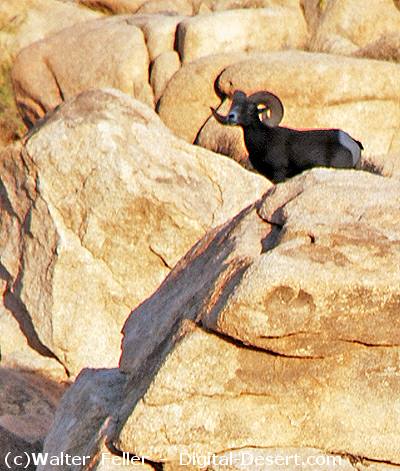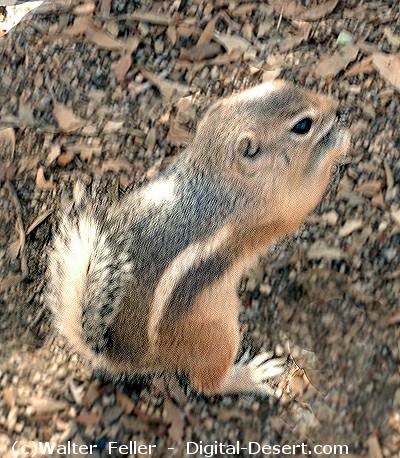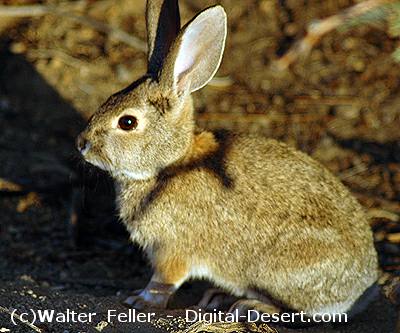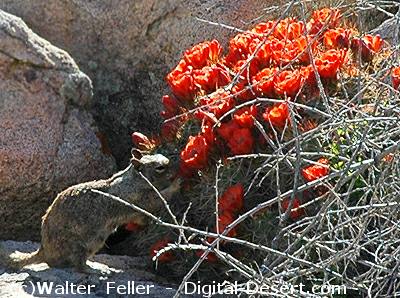Joshua Tree National Park - Wildlife:
Mammals
The chief obstacles to survival in the desert are lack of water, shortage of food, and extreme
temperatures. Mammals, including humans have the ability to maintain a constant body temperature
regardless of external conditions. This has advantages and disadvantages in the desert. Mammals can
endure a large range of air temperatures, but are unable to tolerate even a small change in body
temperature without encountering problems.
When most mammals get hot they perspire, and the evaporation of this water cools them down and
helps maintain a constant body temperature. Some mammals use panting to produce the same effect. Both
methods work well, but they have an important drawback for life in the desert. They involve substantial
loss of water. Where water is in short supply, animals must minimize water loss. Thus, few desert
mammals use perspiration or panting as their main method of keeping cool.
Because scarcity of food in the desert limits the number of large mammals that can be supported, most
desert mammals are small. Joshua Tree National Park is home to 52 species of mammals. Of these, 24
are small rodents. Being small has its advantages and disadvantages. Rodents can burrow into the
ground or hide in rocky crevices to avoid the mid-day heat. But their small body size means that
they can gain or lose body heat rapidly. Many of them plug the entrance to their burrows to keep
out the hot, desiccating air.
Most small mammals make the most of the positive side of being small, spending the day in burrows and
emerging at night when the temperature drops to a more comfortable level. The larger mammals, such as
mule deer and mountain sheep stay close enough to springs to be able to drink daily.
A few desert mammals, such as the round-tailed ground squirrel, a diurnal rodent, enter a state of
aestivation when the days become too hot and the vegetation too dry. They sleep away the hottest
part of the summer. They also hibernate in winter to avoid the cold.
Many of our Joshua Tree mammals are paler in color than their relatives in more moderate environments. Pale
colors not only ensure that the animal will absorb less heat from the environment, but help make it less
conspicuous to predators in the bright, pallid landscape.
Most desert mammals are herbivores and derive water directly from the plants they eat. Some, like kangaroo
rats, have extreme adaptations enabling them to live without ever drinking water. They have super efficient
kidneys that extract most of the water from their urine and return it to the blood. And much of the water
that would be lost in breathing is recaptured in the nasal cavities by specialized organs. If that weren’t
enough, kangaroo rats actually manufacture water metabolically from the digestion of dry seeds!
Badgers, Skunks, Weasels
-
American Badger
Taxidea taxus berlandieri
low desert (uncommon)
Western Spotted Skunk
Spilogale gracilis gracilis
rocky canyons, western part of the park (uncommon)
Long-tailed Weasel
Mustela frenata latirosta
western part of the park (rare)
Bats
Bears
-
California Black Bear
Ursus Americanus californianus
occasional migrant, western part of the park (uncommon)
Canids
-
Desert Coyote
Canis latrans mearnsi
parkwide (common)
Desert Kit Fox
Vulpes macrotis arsipus
parkwide: usually found on desert flats (common)
Desert Gray Fox
Urocyon cinereoargenteus scottii
rocky canyons and outcrop areas, mostly western part (common)
Cats
-
California Mountain Lion
Felis concolor californica
mountains, but wide ranging (uncommon)
Desert Bobcat
Lynx rufus baileyi
parkwide: mostly rocky canyons and outcrops (common)
Ringtails
-
California Ringtail
Bassariscus astutus ocatvus
rocky areas (uncommon)
Deer & Sheep
-
Southern Mule Deer (Blacktail)
Odocoileus hemionus fuliginatus
mountains: western part of the park (common)
Desert Bighorn Sheep
Ovis canadensis nelsoni
mountains (uncommon)
Rabbits & Hares
-
Southern Desert Cottontail
Sylvilagus audubonii arizonae
parkwide: brushy and rocky areas, especially washes and canyon bottoms (common)
Desert Blacktail Jackrabbit
Lepus californicus deserticola
parkwide: mostly mesas and flats (common)
Rodents
-
Dusky Chipmunk
Tamias obscurus davisi
pinyon-juniper woodlands (common)
White-tailed Antelope Squirrel
Ammospermophilus leucurus leucurus
parkwide (common)
Western Mojave Ground Squirrel
Spermophilus beecheyi parvulus
western part of the park, especially rocky areas (common)
Mojave Round-tailed Ground Squirrel
Spermophilus tereticaudus tereticaudus
low desert (common)
Mojave Pocket Gopher
Thomomys bottae mojavensis
loose deep soil, northern part of the park (common)
Coachella Pocket Gopher
Thomomys bottae rupestris
loose deep soil, southeastern part of the park (common)
Eastern Spiny Pocket Mouse
Chaetodipus spinatus spinatus
isolated populations in canyons and near springs (common)
Pallid (San Diego) Pocket Mouse
Chaetodipus fallax pallidus
open desert (common)
Narrow-nosed (Desert) Pocket Mouse
Chaetodipus penicillatus angustirostris
low desert: eastern part (common)
Mojave Little Pocket Mouse
Perognathus longimembris longimembris
parkwide (common)
Mojave Long-tailed Pocket Mouse
Chaetodipus formosus mohavensis
gravel or rocky ground, chiefly rocky washes, canyon mouths, and bajadas (common)
Western Chisel-toothed Kangaroo Rat
Dipodomys microps occidentalis
known only from the Stubbe Spring-Juniper Flat area (rare)
Merriam’s Kangaroo Rat
Dipodomys merriami merriami
parkwide (common)
Desert Kangaroo Rat
Dipodomys deserti
low desert: sandy areas; eastern part (common)
Desert Harvest Mouse
Reithrodontomys megalotis megalotis
known only from Keys View area (rare)
Desert Wood Rat
Neotoma lepida lepida
parkwide: usually in rock outcrops or around larger plants (common)
Eastern Dusky-footed Wood Rat
Neotoma fuscipes simplex
high elevations, western part of the park (uncommon)
White-throated Wood Rat
Neotoma albigula venusta
rocky areas (uncommon)
Southern Brush Mouse
Peromyscus boylii rowleyi
Lost Horse Valley-Queen Valley (uncommon)
Desert Canyon Mouse
Peromyscus crinitus stephensi
parkwide: rocky canyons (common)
Cactus Mouse
Peromyscus eremicus eremicus
parkwide: mesas, foothills, washes (common)
Sonoran Deer Mouse
Peromyscus maniculatus sonoriensis
parkwide (uncommon)
Southern California Pinyon Mouse
Peromyscus truei chlorus
pinyon-juniper woodlands (uncommon)
Desert Grasshopper Mouse
Onychomys torridus pulcher
parkwide, except rocky or steep terrain (common)
House Mouse
Mus musculus domesticus
human areas (common)
Shrews
-
Desert Shrew (Gray)
Notiosorex crawfordi crawfordi
western part, known only from two locations (rare)

Bighorn Sheep stay close to waterholes

White-tailed Antelope Squirrels stay active throughout the day

A furry, cute little cottontail watches for coyotes, hawks, eagles, bobcats and what-not. It seems everybody loves a cottontail.

A rock squirrel takes a moment to stop and smell the roses, er,... clarets as it may be.